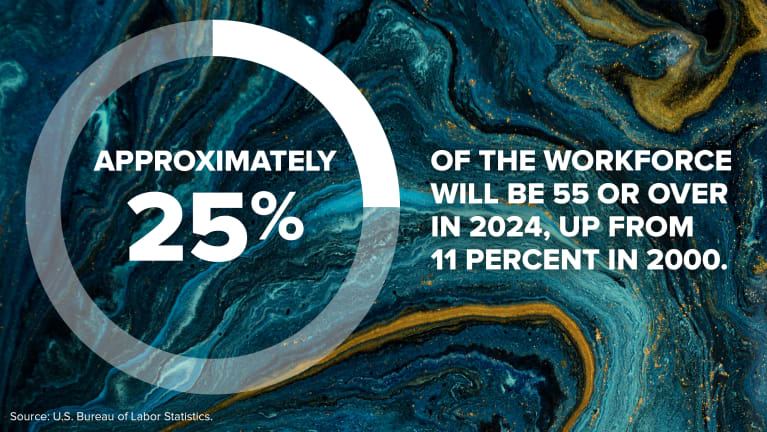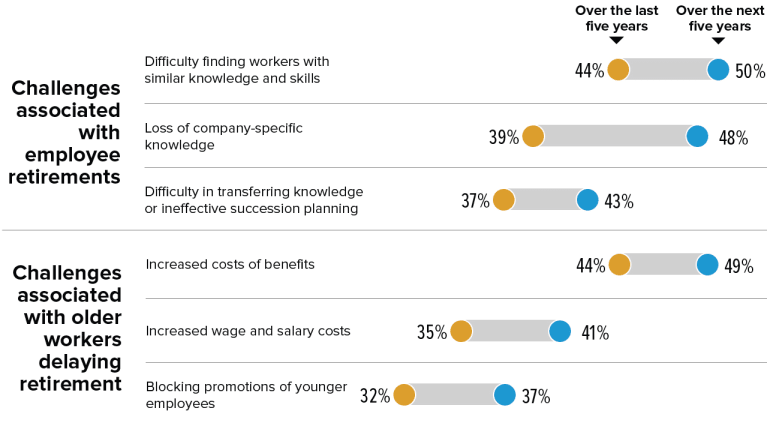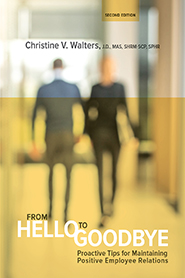Ageism Might Be Sabotaging Your Ability to Hire and Retain Talent
Employers that don't value older workers are doing themselves a disservice.

Understanding the Value of Older Workers
Today's older workers are better educated and living longer than any previous generation. They also want to remain in the workforce longer, but discrimination and outdated assumptions are making that a tricky proposition for many experienced employees, and overt acts of ageism are only expected to get worse as the number of older workers grows.
A recent investigation by ProPublica and the Urban Institute found that 56 percent of workers over age 50 report that they were pushed out of their jobs by their employers before they were ready to retire. Some of the comments heard by those employees include:
- "Older workers can't handle the day-to-day demands of the job."
- "They can't be retrained and are too hard to manage."
- "They cost too much money in salary and benefits."
- "They create too much risk of an employment discrimination claim."
Yet companies that allow biases to run rampant are sabotaging their ability to hire and retain talented teams at a time when they're facing three critical trends: record low unemployment, restricted immigration and an aging workforce that wants to remain actively employed.
Savvy company leaders are meeting those recruiting challenges by hiring and retaining more older workers, including those in their 60s and 70s.
In fact, by 2024, the U.S. labor force is projected to grow to about 164 million people, of whom about 13 million are expected to be ages 65 and older, according to the U.S. Bureau of Labor Statistics. And although they make up a smaller number of workers overall, the 65-to74-year-old and 75-and-older age groups are projected to experience faster labor force growth rates annually than any other group.
Consider Darlyne Robertson's career to understand why. "She joined us in her late 50s as a customer service associate and continues to enjoy her job 17 years later in her mid-70s," says Dave Walker, chief people officer at 1-800 Contacts, a Utah-based retailer that employs more than 350 customer service agents.
"Darlyne is terrific at her job and offers a perspective and stabilizing influence to her team, which adores her," Walker says. "She brings a wealth of experience as her team works to solve everyday problems in order to excel at their jobs and improve as a team." Walker adds that Robertson loves her job so much that she has passed up higher-level roles.
Associates ages 50 and up make up nearly 20 percent of the company's call center staff, and about 10 percent of call center workers are over age 60.
Tips for Fostering an Age-Diverse Workforce
The EEOC recommends the following strategies to increase age diversity in the workplace:
- Assess aspects of your organization's culture, practices or policies that may reveal outdated assumptions about older workers. The Center on Aging & Work at Boston College and AARP partnered to develop such an assessment tool.
- Examine your recruitment practices. Does your website include photos of an age-diverse workforce? Do your job applications ask for age-related information such as date of birth or when a person graduated? Is your interview panel age-diverse? Train recruiters and interviewers to avoid ageist assumptions, such as that a younger worker will work for a lower salary or that an older worker will not remain on the job for long.
- Include age as part of your diversity and inclusion programs and efforts. PricewaterhouseCoopers' 2015 Annual Global CEO Survey found that while 64 percent of 1,322 CEOs in 77 countries had a diversity and inclusion strategy at their company, only 8 percent included age in those strategies. Offer learning and development, including career counseling and reverse-age mentoring, to all employees.
- Foster a multigenerational culture that recognizes ability regardless of age and rejects age stereotypes, just as it would reject stereotypes involving race, disability, national origin, religion or sex.
The Untapped Potential of Hiring Older Employees
Like 1-800 Contacts, many companies around the world are discovering the value of hiring and retaining workers who are long past the traditional retirement age.
Notions that older workers aren't good enough or are too expensive can be easily debunked, says Peter Cappelli, co-author of Managing the Older Worker: How to Prepare for the New Organizational Order (Harvard Business Review Press, 2010) and director of the Center for Human Resources at the Wharton School in Philadelphia.
"The big myth is performance-related: that older workers don't perform as well. Yet on almost every dimension of job performance, research shows that older workers perform better than younger workers," Cappelli says. "They're more conscientious, they're absent less and they have better social skills."
At Skanska USA, an 11,000-employee construction and development firm located in 20 U.S. markets, the focus on hiring employees in their 50s and 60s has never been greater.
"Our employees represent the quintessential knowledge-based workforce that requires real hands-on experience to manage the scope, the risk, the commercial management and the safety needs these complex projects demand," says Chief Human Resources Officer John Benson. As a result, he says, there's a greater emphasis on hiring and retaining an older, more experienced workforce.
"Projects are becoming more complicated, larger in scale and logistically more onerous. So, to encourage older workers to extend their careers with us, we've been offering new, exciting projects and roles, part-time work, flexible work arrangements, project-specific or critical-tasks-oriented consultation arrangements, and an industry-leading compensation/benefits platform," Benson says.

Many smaller companies are taking similar actions. "We've hired many people who are later in their careers that have made great contributions to our organization," says Tracy Stachniak, SHRM-SCP, director of human resources and training and development at Toyota Material Handling in Columbus, Ind., with 168 employees.
"For example, five years ago we hired Anne Ewing, who was in her 50s, to be our national manager of dealer development. Not only does Anne's work yield strong results, she has served as an outstanding professional mentor and is helping us grow and develop our next level of leaders," Stachniak says. "I often refer young professionals to her as a mentor. She's a great role model. Her strong work ethic, maturity and professionalism set a great example for what others should aspire to be as they develop their own careers."
At Encore.org, a national nonprofit, executives are working to reframe the conversation about engaging a multigenerational workforce. "It's time for new models for late-career work," says Marci Alboher, an Encore vice president and author of The Encore Career Handbook: How to Make a Living and a Difference in the Second Half ofLife (Workman Publishing, 2012). "The 'past their prime' stereotype is demonstrably false. Older employees have a tremendous amount of value to offer employers. They simply need the opportunity."
Another way to view the issue is to remove age from the discussion and simply ask: What if someone could virtually guarantee that your workplace would be more collaborative, emotionally intelligent, loyal and wise? says Chip Conley, Airbnb's strategic advisor for hospitality and leadership.
"There's substantial evidence that an age-diverse workplace, especially in industries that tend to exhibit ageism, can lead to more effective teams and companies," says Conley, author of Wisdom @ Work: The Making of a Modern Elder (Currency, 2018) and a speaker at the SHRM 2019 Annual Conference & Exposition. "Research shows that adding some experienced workers results in the team and all team members improving. And this need is occurring at exactly the time that a generation of Boomers are saying, 'I don't want to retire like my parents did.' "
Watch Your Language
While HR leaders and hiring managers may not intend to exclude older workers when they use these common phrases in job descriptions and interview assessments, that can be the unfortunate result, experts say.
| Words to Watch | Why They Matter |
| "Digital native" | May discourage qualified applicants who didn’t come of age with digital and mobile tech—even some as young as their 30s. |
| "High-energy" | Often a euphemism for young. |
| "Ninja" or "guru" | These trendy buzzwords may be unappealing to older candidates. |
| "GPA of 3.5 or higher" | Sends the message that you’re looking for employees at a life stage where these assessments remain relevant. |
| "Overqualified" | Since experience often correlates with age, this term can be used to mask age bias. |
| "Meals included" | Implies an expectation that workers don’t have a family waiting for them to come home for dinner. |
| "Bad cultural fit" | Can be problematic if your culture is overtly youth-oriented. |
Debunking Common Myths About Older Workers
The federal Age Discrimination in Employment Act of 1967 and similar state laws prohibit discrimination against older workers. However, the risk of a claim from older workers is often overblown.
"Older workers face numerous hurdles in proving claims of age discrimination," says plaintiffs' attorney Dana Sullivan of Buchanan Angeli Altschul & Sullivan LLP in Portland, Ore. "Perhaps the most fundamental is the U.S. Supreme Court's determination a decade ago that plaintiffs in age discrimination cases must meet a more stringent standard of proof than employees seeking to prove discrimination based on other protected characteristics.
"Realistically speaking, if an older worker fails to perform and management fires the employee after giving him or her a genuine opportunity to improve, there's little chance that the employer will face liability for age discrimination," Sullivan says.
Employers Are as Concerned about the Loss of Knowledge When Employees Retire as They Are about Rising Costs for Those Who Delay

Source: Willis Towers Watson, Working Late: Managing the Wave of U.S. Retirement, 2018.
Do older workers cost too much? Not really, says Cappelli, since the assumption that older employees won't accept a job at a lower rate of pay, or won't take a step down in title or authority, is often wrong. "When workers are getting toward the end of their careers," he says, "it's not surprising that they'd be willing to step back from some of their authority, hours and pressure, even if this involves a pay cut. However, if you don't ask, you'll never know."
The notion that older workers overburden employee benefit plans is common, but doesn't always stand up to scrutiny. Thomas Kramer, an employee benefits attorney at Bullard Law in Portland, Ore., encourages employers to consider that retirement costs for older workers may be marginally greater than for younger workers, but that would most likely be a function of an older worker's compensation being higher than that of a younger worker doing the same job (due to higher productivity, seniority or other factors).
Employers should also consider:
- If costs for older workers might be greater under a traditional defined benefit pension plan, which determines benefits based on the plan participant's "final average pay," though many employers have eliminated such plans, if they ever had them.
- Whether older workers, seeing more clearly the need for retirement savings, might contribute more heavily to retirement plans than younger workers, increasing costs for employers that match employees' contributions.
- If, with group health benefits, health insurers may charge higher premiums to cover older workers relative to younger ones, though that wouldn't necessarily mean higher costs for the employer.
- How much the organization is willing and able to contribute toward the cost of employees' coverage, regardless of the aggregate premium based on the group's age profile, and how much of the cost of coverage will be borne by the employees.
- Whether to subsidize the cost of health coverage for employees' children, given that older workers are less likely to have children eligible for such coverage (potentially making the cost of coverage for older workers less costly than the cost for younger workers).
- Whether older workers eligible for Medicare will decline coverage under the employer's plan.
- Group life and disability insurers will probably charge higher premiums for coverage for older workers relative to younger ones, which again may not increase the employer's cost. The employer might contribute the same amount for coverage for each eligible employee, understanding that the benefit level for older workers might be lower than for younger workers, unless the older worker contributes an additional amount.
In short, the assumption that benefit costs are higher for older workers may be partially or completely incorrect, depending on the company, Kramer says. With help from their benefits advisors, employers should take a closer look.
Jathan Janove, J.D., is the author of Hard-Won Wisdom: True Stories from the Management Trenches (HarperCollins/Amacom, 2017) and is a columnist for SHRM Online.
Explore Further
 Book Blog: Managing the Employment Relationship
Book Blog: Managing the Employment RelationshipThere are several misconceptions about older workers and the attributes they bring to the workplace. Here are tips on how to avoid them.
ProPublica and Urban Institute Studylexibility, Fairness, Trust, Empowerment Make Work Human
Data analysis by ProPublica and the Urban Institute shows that more than half of older U.S. workers are pushed out of longtime jobs before they choose toretir



